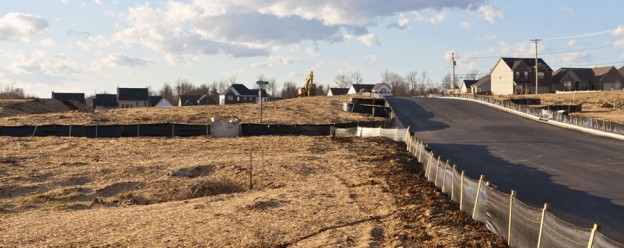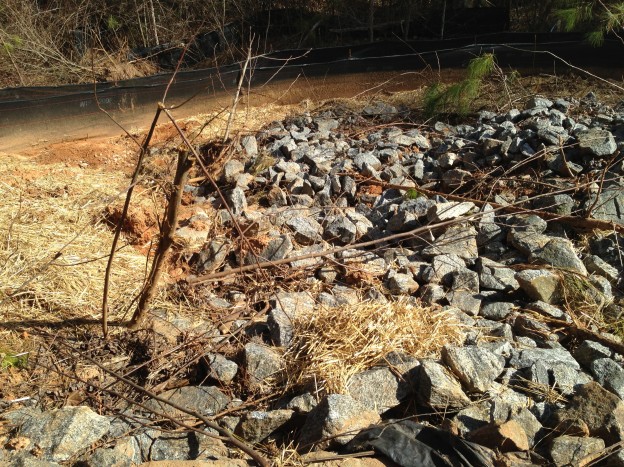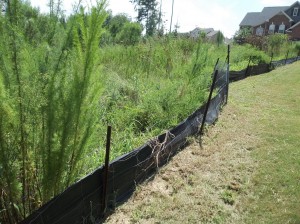The EPD has issued a “No Action Assurance” to aid all individuals involved in land disturbing activity while the new NPDES permit is being completed. This plan will allow NOIs to be filed after the initial expiration date of the existing NPDES General Permit (July 31st, 2013). Click the link below to see the latest update from the EPD.
GSWCC Policy Changes
There’s a lot of changes going on in the erosion and sediment control industry as of late. Let’s take a quick look at what is changing and how it affects your job sites.
Certifications
Did your certification card expire? Don’t worry, it happens more than you would think. Apparently, it happens enough that the state has decided to revise it’s stance on the 90 day expiration policy currently in place.
In the past, when you wanted to get your Level 1A card (blue card), or any level card for that matter, you would research the upcoming courses listed on the Conservation Commission’s website, register for a class, sit through 1 to 2 days worth of training, and pass a test to prove you understood the material as it was presented. At this point, your certification was active and didn’t expire until 3 years from the date of your initial training class. Before your three year period expired, you would need to register for a 4 hour recertification class to validate your certification for another three years. Because so many people were missing the three year mark, the state had put a policy in place allowing you an additional 90 days after the date of your expiration to get your certification renewed. In order to regain your certification once your expiration date had passed the 90 day mark, you would have to sit for the initial 1 to 2 day class and successfully complete the test all over again.
With the recent vote by the Georgia Soil & Water Conservation Commission Board on June 21st, 2013, the policy on renewing your certification has changed. Under the new policy, “individuals will only have to sit for an initial certification course and pass the certification exam once. Effective July 1, 2013, individuals seeking to extend or renew an expired certification, regardless of how long a certification has been expired, must attend at least four (4) hours of continuing education.”
So what does this mean for you? In short, once you’ve taken the initial class and passed the test for any level certification, you are considered certified. And, once your card has expired, you are no longer considered certified. Neither of these two facts have changed. However, if you wish to renew your expired certification, you will now only have to take a 4 hour recertification course as opposed to retaking the initial class and test like you would under the old policy.
Be sure to stay on top of your expiration dates, “This policy change only pertains to an individual’s certification status, therefore, if an individual conducts a land disturbing activity with an expired certification, that individual is in noncompliance with O.C.G.A.12-7-1 and may be subject to enforcement action.”
GSWCC Region 3
As of June 28th, 2013, the Region 3 office of the Georgia Soil and Water Conservation Commission has closed. If Region 3 is usually the one who handles the technical review and ratification of your Erosion Sedimentation and Pollution Control Plans, you’ll need to be sure to submit them to the appropriate office instead:
Cobb, Dekalb, Fulton, Gwinnett
GA Soil and Water Conservation Commission
Susan Castle, Erosion and Sediment Control Specialist
90 Lanthier Street
Winder GA 30680
Clayton, Henry, Rockdale
GA Soil and Water Conservation Commission
Guerry Thomas, Resource Specialist
Aubrey Harvey Building
333 Phillips Drive
McDonough, Ga. 30253
NPDES General Permit
The new NPDES General Permit goes into effect August 1st 2013. When this occurs, we’ll be sure to update you on all of the changes and how they affect you.

Compliance Begins With The Permit Box
When an inspector enters your job site to perform an inspection, the first place they are trained to look is the permit box. Usually, this is as far as they need to go to find a problem. Record keeping violations continually rank among the top offenses on construction sites in the state of Georgia and can carry a fine as large as $2,500 per violation, per day. Fines like these can add up quickly and cripple a company’s ability to turn a profit on a job. Let’s take a look at what you need to have available on site at all times.
“The primary permittee shall retain the following records at the construction site or the records shall be readily available at a designated alternate location from commencement of construction until such time as a NOT is submitted in accordance with Part VI.” – Part IV.F.1, GAR 100003
1. Notice of Intent (NOI) & Proof of Submittal
First, remember that your notice of intent needs to be filed via certified mail with return receipt at least 14 days prior to any type of construction activity on your job site. This form can be found on the GA EPD’s website under the Stormwater section. Once this is complete, you will need to keep a signed copy of the NOI along with the proof of submittal and any fee forms on site. Again, make sure you have a signed copy. A NOI without a signature will not be accepted.
2. Copy of the Erosion Sedimentation & Pollution Control Plan (ESPCP)
Every construction site in the state of Georgia that requires coverage under the NPDES General Permit calls for an Erosion Sedimentation & Pollution Control Plan (ESPCP). An approved copy of this plan needs to be on site at all times. If you prefer to keep a copy in your truck, make sure that you have an additional approved copy that can stay on the job site. Inspectors need to be able to access the plans during non-working hours, holidays, and rain days as well. Also, make sure that you redline your plans as your jobsite changes. For instance, if you move a stockpile of dirt from one area of the job to another, make sure these changes are reflected on the plan. Use a red pen to show the new location of the stockpile and sign and date it to complete the update. But remember, any time you are making changes to BMPs that have a hydraulic capacity (ponds, inlets, etc.) you can’t use the redline process. These changes need to be made by a design professional and approved by the local issuing authority and/or the State.
3. Design Professional Inspection Report (Seven Day Letter)
Once all of your perimeter BMPs, construction exits, and initial sediment ponds are in, you have seven days to schedule an inspection with the design professional who prepared the ESPCP. After this inspection is complete, you will need to retain a copy of this inspection in your logbook. This is a crucial, and often overlooked, step in the NPDES process.
4. Water Quality Monitoring Information
Your job site needs to be sampled at two different times during the course of construction, 1) at the completion of clearing and grubbing, and 2) after all mass grading is complete or 90 days after the first sample was taken. If at any point your samples return deficient results, you will need to continue sampling with each 0.5” rain event until you have readings within your allowable limits. These results will need to be submitted to the EPD via certified mail with return receipt and retained on site. Be sure to keep signed copies of the sampling results along with your receipts from the postal service.
5. Site Inspection Reports
All inspection reports will need to be kept on site at all times. Remember, there are three different types of inspections that occur for any given site. 1) Daily Inspections: These will cover fuel storage areas, construction exits, and a measurement of the daily rainfall. 2) Weekly / Post Rainfall Inspections: These inspections will look at all BMPs, outfalls, and any areas that have not undergone final stabilization. 3) Monthly Inspections: This inspection focuses on all areas of the site that have reached final stabilization.
6. Violation Summary
When an inspection of any kind results in the discovery of a violation, you are required to make note of it in two separate places, 1) in the inspection report that revealed the violation, and 2) in the Violation Summary section of your log book. The EPD also asks that these violations be reported to them within 14 days of discovery. Keep in mind that not every deficiency on site is a violation. Check out the EPDs Enforcement Actions for a few examples of what constitutes a violation.
7. Rainfall Data
It is essential to be aware of how much rain you receive on your job site. The EPD requires that you measure rainfall in 24-hour periods and keep the data in your logbook. Try and check the rain gauge at the same time every day in order to get an accurate representation of what’s really going on your site. Make it part of your routine first thing in the morning and ensure that you’re staying in compliance with this area of the permit.
Records Retention
The NPDES General Permit requires that all records related to the construction site be retained at the permittee’s primary place of business for at least three years from the date of the Notice of Termination (NOT). This period may also be extended by request of the EPD at any time.
Now that you know, there’s no excuse for not keeping your site up to date at all times. Remember, the permit box is the first place your inspector is trained to go when they enter your site. In their eyes, a well-kept logbook usually means a well-kept construction site.
—Article submitted by Jason Hand, May 2013—

What is NPDES & why do we need it?
This question plagues the construction industry on a daily basis and is one of the largest overlooked line items on job sites everywhere. NPDES stands for National Pollutant Discharge Elimination System. In a nutshell, the NPDES permit allows your site to discharge stormwater into waters of the state. And believe it or not, most construction sites require it.
I’ve devoted my entire career in the construction industry to one thing and one thing only…regulatory compliance, and more specifically, NPDES compliance. I’ve sat with customers in boardrooms, court rooms, and class rooms, and the number one question I hear in regards to compliance is WHY?
Why do I need NPDES inspections?
This is an easy one. Any non-exempt land disturbing activity that is greater than 1 acre requires us to file for coverage under the NPDES General Permit. To do so, we need to submit a NOI (Notice of Intent) to the Environmental Protection Division. Once this has been submitted, the law requires that we perform routine inspections until our project is complete. When our project is wrapped up, we can close out this permit with a Notice of Termination and cease inspections.
Why should I worry about it now? I’ve never done inspections before.
This can be one of the tougher questions to answer.. NPDES compliance can, and often does, get overlooked. One of the hardest things to explain to a contractor is the fact that just because it wasn’t an issue on THIS job, doesn’t mean it won’t be one on the next job. We tend to gain a false sense of confidence when we’ve gone about our daily routines for so long on job sites and never even uttered the word NPDES, much less tried to comply with any of the rules and regulations associated with it. We have to remember that NPDES is the law. State and Federal laws are beginning to tighten up and the topic of clean water has never been on the forefront of so many people’s minds. Also, as awareness and laws begin to strengthen, so does our economy. Construction, and more specifically home building, is on the rise again. As construction begins to pick up, governing agencies are able to afford to fund positions for regulatory inspectors. As the number of regulatory inspectors increase, the chances of having one pop in on your job site goes up dramatically.
What happens if I get caught?
Ah, the money question. If you get caught operating without a permit on a site that requires NPDES permitting, you’re opening yourself up to a firestorm from your governing agency. Let’s start from the beginning. Regulatory officials are trained to issue immediate stop work orders on any site without an active permit. This puts your crews and your subs on halt, potentially costing you hundreds or even thousands of dollars. Fines and penalties come next and vary in severity from case to case. The state of Georgia allows inspectors to levy fines up to $2,500 per violation, per day. How many potential violations do you have on your site? Operating without a permit would most likely be the first one listed. The most severe and overlooked penalty would be the possibility of imprisonment, especially if it can be proved in a court of law that you were knowingly circumventing your responsibilities.

Now that you know a little bit about the problem, let’s talk about how to fix it.
Get certified.
The state of Georgia requires that any person involved in land disturbing activity obtain a Blue Card (Level 1a). The Blue Card program is designed to educate these individuals on topics such as the Clean Water Act, NPDES Permits, and common problems found on construction sites. Depending on your level of involvement, there are also a few more certifications you may be interested in as well.
Keep your site in compliance.
According to the permit, NPDES inspections need to be performed at 4 different intervals: daily, weekly, post rainfall, and monthly. Know what’s required for each type of inspection and be sure to get them done on time. Next, make sure that you are pulling water quality samples. The permit requires us to sample 2 distinct discharge events. 1) After clearing and grubbing, and 2) 90 days from the first sample or after mass grading, whichever comes first. Did any of your samples fail? Don’t forget that the permit requires us to keep sampling every rain event until we meet the turbidity standards required by the permit.
Be proactive.
We’ve all heard the saying, “an ounce of prevention is worth a pound of cure”. Use this mantra as a daily routine on your site. Stay ahead of the storms by making sure that your erosion control devices are installed properly. Also, don’t forget to provide routine maintenance to any measures that may be in need. Don’t always take the cheap route either. There’s a lot to be said about doing it right the first time. And last but not least…
Ask a specialist.
Our pride loves to play tricks on our mind. Knowing that there’s someone out there who’s better at this than we are is an intimidating thought process. Don’t be scared to reach out to those who deal with this type of thing on a daily basis.
—Article submitted by Jason Hand, April 2013—




